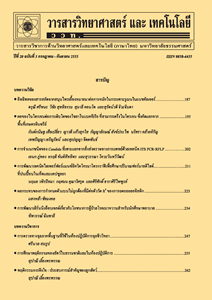Comparison of Efficiency for Parametric and Nonparametric Tests in Multiple Comparisons of a Completely Randomized Designs
Main Article Content
Abstract
This research purposed to study and compare the efficiencies of multiple comparisons tests with and without parameter of completely randomized design consisting of 6 tests, i.e., Student-Newman-Keul’s test (SNK test), Duncan’s new multiple range test, Waller-Duncan test, Conover test, van der Waerden test and Nemenyi test. The study was conducted in data randomly obtained from normal distribution, gamma distribution and log-normal distribution. For the probability calculation of type I error and power of a test using identical and different sample sizes, divided into small size, medium size and large size, i.e., (10,10,10), (30,30,30), (50,50,50), (5,10,15), (25,30,35) and (45,50,55), and there were 2 levels of significance: 0.01 and 0.05. The results of the study, according to objective 1, indicated that for every situation, the best probability control capability of type I error was found in Student-Newman-Keul’s test, Duncan’s new multiple range test, Waller-Duncan test, Conover test and van der Waerden test. As Weller-Duncan test provided the best power of a test for every situation and the results of the study, according to objective 2, Waller-Duncan test is most suitable for testing data with normal distribution, gamma distribution and log-normal distribution.
Article Details
References
Sinsomboonthong, S., 2015, Experimental Design 1, Chamchuree Products, Co., Ltd., Bangkok, 547 p. (in Thai)
Worayangkun, S., 1988, Comparisons of the Power of a Test Between Parametric and Nonparametric Tests in Multiple Comparisons of a Randomized Complete Block Design, Master thesis, Chulalongkorn University, Bangkok. (in Thai)
Francisco, D.A.S.S. and Carlos, A.V.D.A., 2016, Comparison of means of agricultural experimentation data through different tests using the software assistant, Afr. J. Agric. Res. 11: 3527-3531.
Armando, C., Décio, B. and Clarice, G.B.D., 2008, Modifications for the Tukey test procedure and evaluation of the power and efficiency of multiple comparison procedures, Sci. Agric. 65: 428-432.
Douglas, C.E., 2019, Multiple Comparisons: Philosophies and Illustrations, Available Source: http://www.physiology.org/journal/ajpregu, May 1, 2019.
Pinchoo, P., 2007, Comparisons of type I error rates and power of the test in post hoc comparison procedures for completely randomized design, J. Res. Meth. 20(3): 331-351. (in Thai)
Ozkaya, G. and Ercan, I., 2012, Examining multiple comparison procedures according to error rate, power type and false discovery rate, J. Mod. Appl. Stat. Met. 11: 348-360.
David, J.S., 2012, Multiple comparison procedures-cutting the gordian knot, Agron. J. 107: 730-735.
Boardman, T.J. and Moffitt, D.R., 1971, Graphical Monte Carlo type I error rates for multiple comparison procedures, Biometrics 27: 738-744.
Khumsaard, N., 2009, Power of Test on Multiple Comparison, Master Thesis, Srinakharinwirot University, Bangkok, 112 p. (in Thai)
Carmer, S.G. and Walker, W.M., 1985, Pairwise multiple comparisons of treatment means in agronomic research, J. Agron. Educ. 14: 19-26.
Bradley, J.V., 1978, Robustness, J. Math. Stat. Psychol. 31: 144-152.


